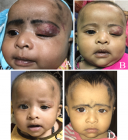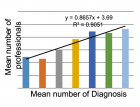Abstract
Research Article
Association between clinical forms of Leprosy and contacts with the vaccination state with BCG in five endemic municipalities in the Brazilian Amazon
Maria do Perpétuo Socorro Amador Silvestre*, Maxwell Furtado de Lima and E Luana Nepomuceno Gondim Costa Lima
Published: 19 July, 2022 | Volume 5 - Issue 1 | Pages: 001-004
Introduction: The World Health Organization (WHO) strategy for leprosy control from 2021 to 2030 focuses on interrupting transmission, reducing autochthonous cases to zero, and using a safe and effective vaccine and chemoprophylaxis. In 2020, 127,396 new cases were registered in the world, 19,195 new cases in the Americas, and, of these, 17,979 cases in Brazil, about 93.66% of the total in the Americas. Brazil is classified as a country with a high burden of the disease, occupying the 2nd place in the world, behind only India (WHO, 2020). Análise do período de 2010-2015 em publicação recente9, apresenta as seguintes cidades no estado do Pará nas quais se observou maiores taxas de incidência (detecção): Marituba, Belém, Marabá, Parauapebas e Altamira [9].
Material and method: This is an analytical retrospective study carried out in a database - Epi-Info resulting from records of Surveillance and Seroprevalence actions in five endemic municipalities for leprosy located in the Southeast and West of Pará. The following variables were analyzed: age, sex, Clinical Classification, vaccination status with BCG, and the result of the search for IgM antibodies against PGL-1 of Mycobacterium leprae by the “In house” ELISA technique.
Results: We evaluated 1551 records examined in the laboratory from 2014 to 2016, which were classified into 123 Multibacillary -MB patients (123/1551 = 7.93%); 71 Paucibacillary-PB patients (71/1551 = 4.57%); 451 Intradomicilliary Consanguineous Contacts - CCOSI (451/1551 = 29.07%) and 906 Non Consanguineous Contacts - CNCOS (906/1551 = 58.41%). 57 MB patients (13.47%), 13 PB patients (3.07%), 133 CCOSI (31.44%) and 220 CNCOS (52.00%) were positive for PGL-1. The correlation of the Classification with the vaccination status showed 57 MB patients without any BCG (57/125 = 45.6%) and only 3 patients with two doses of BCG (3/125 = 2.4%); 17 PB patients without any dose of BCG (17/69 = 24.63%); 80 CCOSI without any BCG (80/455 = 17.58%) and 171 CNCOS (171/906 = 18.87%). The odds ratio (OR) in the analysis between unvaccinated MB patients compared to CCOSI was statistically significant (OR = 14.25; p ˂ 0.0001). The study shows the importance of using the BCG vaccine in healthy contacts of patients with leprosy, as it shows the probability of unvaccinated individuals being 14.25 times more likely to become ill with Multibacillary forms compared to CCOSI. In addition, the BCG vaccine has been in use for 80 years and is the only vaccine that we can use in leprosy control programs.
Conclusion: Although the leprosy epidemiological data analyzed recently (2010 - 2015) show a downward trend in the main indicators in Pará, such as the detection of new cases and prevalence, the endemic municipalities are still classified as hyperendemic for the population under 15 years of age and This proves that Surveillance is essential, as well as BCG vaccination according to the Ministry of Health Standards.
Read Full Article HTML DOI: 10.29328/journal.ijcmbt.1001024 Cite this Article Read Full Article PDF
References
- World Health Organization – WHO. Towards zero leprosies. Global leprosy (Hansen's disease) strategy 2021 – 2030. ISBM – 978-92-9022-850-9
- Andrade RO. The persistence of leprosy. Epidemiological Bulletin. Edition 283, 2019.
- Bricks LF. Vacina BCG: via percutânea ou intradérmica? [Percutaneous or intradermal BCG vaccine?]. J Pediatr (Rio J). 2004 Mar-Apr;80(2):93-8. Portuguese. PMID: 15079177.
- World Health Organization – WHO. Weekly Epidemiological Record. 2004; 79: 25–40. http/www.who.int/wer
- Cunha MD, Santos RS, Matos HJ, Oliveira MLW. Epidemiological aspects of leprosy. Cad. Public Health, Rio de Janeiro. June 2012; 28(6): 1143–1155.
- Barreto ML, Pereira SM, Ferreira AA. BCG vaccine: efficacy and indications for vaccination and revaccination. J Pediatr (Rio J). 2006 Jul;82(3 Suppl):S45-54. doi: 10.2223/JPED.1499. PMID: 16826312.
- Lombardi C, Pedrazzani ES, Pedrazzani JC, Ferreira Filho P, Zicker F. Eficacia protectora del BCG contra la lepra en São Paulo, Brasil [The protective efficacy of BCG against leprosy in São Paulo, Brazil]. Bol Oficina Sanit Panam. 1995 Nov;119(5):415-21. Spanish. PMID: 8540997.
- Silvestre MPSA, Lima LNGC, Araújo AB, Quaresma JAS. Polymorphism of the human NRAMP1 gene, anti-PGL-I antibody levels and leprosy susceptibility in endemic areas of Pará State, Brazil. Rev Pan-Amaz Saude. 2012 Dec;3(4):17-26.
- Pires CAA, Chaves EC, Salmen CF, Balieiro ABR, santos MBL, Filho GGA. Analysis of the clinical-epidemiological profile of leprosy in Pará and evaluation of health indicators. Reas/EJCH. 2019; 27.
- Ministry of Health. National Secretariat for Special Programs. National Division of Sanitary Dermatology. Secretary of State for Public Health – SESPA. Leprosy epidemiological indicators report, 2016.
- Neto BF, Sílvia ER, Geha YF, Santos JNG, Mota JV, Pereira WMN. Leprosy in the state of Pará: spatial and temporal patterns visualized by the analysis of epidemiological indicators from 2004 to 2018. Research Society and development. 2021; 10.
- Ministry of Health. Health Surveillance Department. Special Epidemiological Bulletin, 2021. Publisher MS/CGDI.
- Bührer SS, Smits HL, Gussenhoven GC, van Ingen CW, Klatser PR. A simple dipstick assay for the detection of antibodies to phenolic glycolipid-I of Mycobacterium leprae. Am J Trop Med Hyg. 1998 Feb;58(2):133-6. doi: 10.4269/ajtmh.1998.58.133. PMID: 9502593.
- Foss NT. Immunological aspects of leprosy. Medicine, Ribeirão Preto, 1997; 30: 335-339.
- Goulart IM, Penna GO, Cunha G. Imunopatologia da hanseníase: a complexidade dos mecanismos da resposta imune do hospedeiro ao Mycobacterium leprae [Immunopathology of leprosy: the complexity of the mechanisms of host immune response to Mycobacterium leprae]. Rev Soc Bras Med Trop. 2002 Jul-Aug;35(4):365-75. Portuguese. doi: 10.1590/s0037-86822002000400014. PMID: 12170333.
- Carvalho FM. Mycobacterium leprae-specific in vitro cellular immune response from contacts of patients with multibacillary leprosy at baseline and during treatment of the index case. [Thesis (Master's degree]. Oswaldo Cruz Institute. Postgraduate in Cellular and Molecular Biology. Rio de Janeiro, 2013. 142.
Figures:
Similar Articles
-
Oral Candida colonization in HIV-infected patients: Species and antifungal susceptibility in Tripoli/LibyaEllabib M*,Mohamed H,Mokthar E,Ellabib M,El Magrahi H,Eshwika A. Oral Candida colonization in HIV-infected patients: Species and antifungal susceptibility in Tripoli/Libya . . 2018 doi: 10.29328/journal.ijcmbt.1001001; 1: 001-008
-
Evaluation of novel culture media prepared from plant substrates for isolation and identification of Cryptococcus Neoformans Species ComplexEllabib M*,Krema ZA,Mokthar ES,El Magrahi HS,Eshwika A,Cogliati M. Evaluation of novel culture media prepared from plant substrates for isolation and identification of Cryptococcus Neoformans Species Complex. . 2018 doi: 10.29328/journal.ijcmbt.1001002; 1: 009-013
-
Trypanosoma dionisii as an experimental model to study anti-Trypanosoma cruzi drugs: A comparative analysis with benznidazole, posaconazole and amiodaroneDe Souza W*,Barrias ES,Borges TR. Trypanosoma dionisii as an experimental model to study anti-Trypanosoma cruzi drugs: A comparative analysis with benznidazole, posaconazole and amiodarone. . 2018 doi: 10.29328/journal.ijcmbt.1001003; 1: 014-023
-
A Review on filaricidal activity of phytochemical extracts against filariasis and the Parasites Genomic DiversityAM Gumel*,MM Dogara. A Review on filaricidal activity of phytochemical extracts against filariasis and the Parasites Genomic Diversity. . 2018 doi: 10.29328/journal.ijcmbt.1001004; 1: 024-032
-
Host biomarkers for early diagnosis of infectious diseases: A comprehensive reviewArindam Chakraborty*,Singh Monica. Host biomarkers for early diagnosis of infectious diseases: A comprehensive review. . 2019 doi: 10.29328/journal.ijcmbt.1001005; 2: 001-007
-
Virulence Genes in Pseudomonas Aeruginosa Strains Isolated at Suez Canal University Hospitals with Respect to the Site of Infection and Antimicrobial ResistanceNermine Elmaraghy*,Said Abbadi,Gehan Elhadidi,Asmaa Hashem,Asmaa Yousef. Virulence Genes in Pseudomonas Aeruginosa Strains Isolated at Suez Canal University Hospitals with Respect to the Site of Infection and Antimicrobial Resistance. . 2019 doi: 10.29328/journal.ijcmbt.1001006; 2: 008-019
-
Knowledge, perception and practices of Suez Canal University students regarding Hepatitis C Virus infection risk and means of preventionNermine Elmaraghy*,Hesham El-Sayed,Sohair Mehanna,Adel Hassan,Mahmoud Sheded,Maha Abdel-Fattah,Samar Elfiky,Nehal Lotfy,Zeinab Khadr. Knowledge, perception and practices of Suez Canal University students regarding Hepatitis C Virus infection risk and means of prevention. . 2019 doi: 10.29328/journal.ijcmbt.1001007; 2: 020-027
-
in silico discovery of potential inhibitors against Dipeptidyl Peptidase-4: A major biological target of Type-2 diabetes mellitusNouman Rasool*,Andleeb Subhani,Waqar Hussain,Nadia Arif. in silico discovery of potential inhibitors against Dipeptidyl Peptidase-4: A major biological target of Type-2 diabetes mellitus. . 2020 doi: 10.29328/journal.ijcmbt.1001008; 3: 001-010
-
Production and evaluation of enzyme-modified lighvan cheese using different levels of commercial enzymesMohammad B Habibi Najafi*,Mohammad Amin Miri. Production and evaluation of enzyme-modified lighvan cheese using different levels of commercial enzymes. . 2020 doi: 10.29328/journal.ijcmbt.1001009; 3: 011-016
-
Development of ELISA based detection system against C. botulinum type BArti Sharma*,S Ponmariappan. Development of ELISA based detection system against C. botulinum type B. . 2020 doi: 10.29328/journal.ijcmbt.1001010; 3: 017-020
Recently Viewed
-
The Pierre Marie-Sainton syndrome: Report of a familySalem Y*,Omar Y,Dorsaf S,Sonia M,Samir B,Olfa B . The Pierre Marie-Sainton syndrome: Report of a family. J Oral Health Craniofac Sci. 2019: doi: 10.29328/journal.johcs.1001028; 4: 012-014
-
The Bacteriological Profile of Nosocomial Infections at the Army Central Hospital of BrazzavilleMedard Amona*,Yolande Voumbo Matoumona Mavoungou,Hama Nemet Ondzotto,Benjamin Kokolo,Armel Itoua,Gilius Axel Aloumba,Pascal Ibata. The Bacteriological Profile of Nosocomial Infections at the Army Central Hospital of Brazzaville. Int J Clin Microbiol Biochem Technol. 2025: doi: 10.29328/journal.ijcmbt.1001032; 8: 009-022
-
Gentian Violet Modulates Cytokines Levels in Mice Spleen toward an Anti-inflammatory ProfileSalam Jbeili, Mohamad Rima, Abdul Rahman Annous, Abdo Ibrahim Berro, Ziad Fajloun, Marc Karam*. Gentian Violet Modulates Cytokines Levels in Mice Spleen toward an Anti-inflammatory Profile. Arch Asthma Allergy Immunol. 2024: doi: 10.29328/journal.aaai.1001034; 8: 001-006
-
A Resurgence of the Idea of Hypertriglyceridemia and Lower Serum (HDL-C) as Predictive Factors for Insulin Resistance (IR) & Type 2 Diabetes Mellitus Development: A Narrative ReviewKulvinder Kochar Kaur*. A Resurgence of the Idea of Hypertriglyceridemia and Lower Serum (HDL-C) as Predictive Factors for Insulin Resistance (IR) & Type 2 Diabetes Mellitus Development: A Narrative Review. New Insights Obes Gene Beyond. 2025: doi: 10.29328/journal.niogb.1001022; 9: 001-012
-
Novel Mutation in Famous Gene Diseases in Red Blood CellsMahdi Nowroozi*. Novel Mutation in Famous Gene Diseases in Red Blood Cells. New Insights Obes Gene Beyond. 2025: doi: 10.29328/journal.niogb.1001023; 9: 013-020
Most Viewed
-
Causal Link between Human Blood Metabolites and Asthma: An Investigation Using Mendelian RandomizationYong-Qing Zhu, Xiao-Yan Meng, Jing-Hua Yang*. Causal Link between Human Blood Metabolites and Asthma: An Investigation Using Mendelian Randomization. Arch Asthma Allergy Immunol. 2023 doi: 10.29328/journal.aaai.1001032; 7: 012-022
-
Impact of Latex Sensitization on Asthma and Rhinitis Progression: A Study at Abidjan-Cocody University Hospital - Côte d’Ivoire (Progression of Asthma and Rhinitis related to Latex Sensitization)Dasse Sery Romuald*, KL Siransy, N Koffi, RO Yeboah, EK Nguessan, HA Adou, VP Goran-Kouacou, AU Assi, JY Seri, S Moussa, D Oura, CL Memel, H Koya, E Atoukoula. Impact of Latex Sensitization on Asthma and Rhinitis Progression: A Study at Abidjan-Cocody University Hospital - Côte d’Ivoire (Progression of Asthma and Rhinitis related to Latex Sensitization). Arch Asthma Allergy Immunol. 2024 doi: 10.29328/journal.aaai.1001035; 8: 007-012
-
An algorithm to safely manage oral food challenge in an office-based setting for children with multiple food allergiesNathalie Cottel,Aïcha Dieme,Véronique Orcel,Yannick Chantran,Mélisande Bourgoin-Heck,Jocelyne Just. An algorithm to safely manage oral food challenge in an office-based setting for children with multiple food allergies. Arch Asthma Allergy Immunol. 2021 doi: 10.29328/journal.aaai.1001027; 5: 030-037
-
Snow white: an allergic girl?Oreste Vittore Brenna*. Snow white: an allergic girl?. Arch Asthma Allergy Immunol. 2022 doi: 10.29328/journal.aaai.1001029; 6: 001-002
-
Cytokine intoxication as a model of cell apoptosis and predict of schizophrenia - like affective disordersElena Viktorovna Drozdova*. Cytokine intoxication as a model of cell apoptosis and predict of schizophrenia - like affective disorders. Arch Asthma Allergy Immunol. 2021 doi: 10.29328/journal.aaai.1001028; 5: 038-040

If you are already a member of our network and need to keep track of any developments regarding a question you have already submitted, click "take me to my Query."


















































































































































